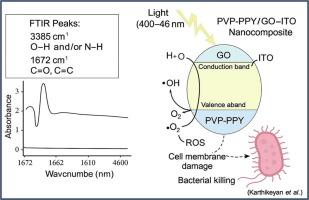Impact of GO and ITO nanostructures’ performance on the nanostructure and optical behavior of a newly fabricated blended-PPY conductive polymer for antibacterial applications
Q1 Social Sciences
引用次数: 0
Abstract
Hybrid nanomaterials are attracting growing attention for their ability to improve the functional performance of polymer-based systems, making them strong contenders for advanced applications in the electronics and biomedical fields. In this study, novel hybrid nanocomposites were developed based on a polyvinylpyrrolidone (PVP) K30 matrix blended with the conductive polymer polypyrrole (PPy) and reinforced with graphene oxide (GO) and indium tin oxide (ITO) nanoparticles. The nanocomposites were fabricated using a solution-casting technique, with improved dispersion achieved through mechanical stirring and ultrasonication. Field emission scanning electron microscope (FESEM) images revealed a smooth surface morphology and an homogeneous distribution of nanomaterials within the polymer matrix. Meanwhile, Fourier transform infrared spectroscopy (FTIR) indicated strong physical interactions between the composite components, with X-ray diffraction confirming the semicrystalline behavior of PVP, which was strongly impacted by the contribution of the nanomaterials. UV–Vis spectroscopy showed significantly enhanced optical behavior, with a notable reduction in the optical band gap from ∼3.43 to 1.63 eV, indicating improved electronic transition efficiency. Furthermore, the well-dried solid films exhibited superior antibacterial activity, with inhibition zones increasing by 53.8% against Staphylococcus aureus and 46.1% against Escherichia coli. These findings highlight the novelty and multifunctionality of the developed nanocomposites, demonstrating their strong potential for use in flexible optical-electronics devices, antibacterial coatings, tissue engineering, and sensor applications and addressing current societal needs in the health, environmental, and medical sectors.

氧化石墨烯和ITO纳米结构对新型聚吡咯导电聚合物纳米结构和光学性能的影响
杂化纳米材料因其改善聚合物基体系功能性能的能力而受到越来越多的关注,使其成为电子和生物医学领域先进应用的有力竞争者。在这项研究中,基于聚乙烯吡咯烷酮(PVP) K30基体与导电聚合物聚吡咯(PPy)共混,并以氧化石墨烯(GO)和氧化铟锡(ITO)纳米颗粒增强,开发了新型杂化纳米复合材料。采用溶液铸造技术制备纳米复合材料,并通过机械搅拌和超声波改善了分散效果。场发射扫描电镜(FESEM)图像显示,聚合物基体表面形貌光滑,纳米材料分布均匀。同时,傅里叶变换红外光谱(FTIR)表明复合组分之间存在强烈的物理相互作用,x射线衍射证实PVP的半晶行为,这受到纳米材料的贡献的强烈影响。UV-Vis光谱显示出明显增强的光学行为,光学带隙从~ 3.43 eV显著减小到1.63 eV,表明电子跃迁效率提高。干燥后的固体膜对金黄色葡萄球菌和大肠杆菌的抑制面积分别提高了53.8%和46.1%。这些发现突出了所开发的纳米复合材料的新颖性和多功能性,展示了它们在柔性光电器件、抗菌涂层、组织工程和传感器应用以及解决当前健康、环境和医疗领域的社会需求方面的强大潜力。
本文章由计算机程序翻译,如有差异,请以英文原文为准。
求助全文
约1分钟内获得全文
求助全文
来源期刊

Journal of Biosafety and Biosecurity
Social Sciences-Linguistics and Language
CiteScore
6.00
自引率
0.00%
发文量
20
审稿时长
41 days
 求助内容:
求助内容: 应助结果提醒方式:
应助结果提醒方式:


